
RESEARCH Open Access
Characterization of a new simian
immunodeficiency virus strain in a naturally
infected Pan troglodytes troglodytes chimpanzee
with AIDS related symptoms
Lucie Etienne
1
, Eric Nerrienet
2,3
, Matthew LeBreton
4
, Godwin Tafon Bibila
5
, Yacouba Foupouapouognigni
2
,
Dominique Rousset
2
, Ahmadou Nana
4
, Cyrille F Djoko
4
, Ubald Tamoufe
4
, Avelin F Aghokeng
1,6
,
Eitel Mpoudi-Ngole
6
, Eric Delaporte
1
, Martine Peeters
1*
, Nathan D Wolfe
4,7
, Ahidjo Ayouba
1
Abstract
Background: Data on the evolution of natural SIV infection in chimpanzees (SIVcpz) and on the impact of SIV on
local ape populations are only available for Eastern African chimpanzee subspecies (Pan troglodytes schweinfurthii),
and no data exist for Central chimpanzees (Pan troglodytes troglodytes), the natural reservoir of the ancestors of
HIV-1 in humans. Here, we report a case of naturally-acquired SIVcpz infection in a P.t.troglodytes chimpanzee with
clinical and biological data and analysis of viral evolution over the course of infection.
Results: A male chimpanzee (Cam155), 1.5 years, was seized in southern Cameroon in November 2003 and
screened SIV positive during quarantine. Clinical follow-up and biological analyses have been performed for 7 years
and showed a significant decline of CD4 counts (1,380 cells/mm
3
in 2004 vs 287 in 2009), a severe
thrombocytopenia (130,000 cells/mm
3
in 2004 vs 5,000 cells/mm
3
in 2009), a weight loss of 21.8% from August
2009 to January 2010 (16 to 12.5 kg) and frequent periods of infections with diverse pathogens.
DNA from PBMC, leftover from clinical follow-up samples collected in 2004 and 2009, was used to amplify
overlapping fragments and sequence two full-length SIVcpzPtt-Cam155 genomes. SIVcpzPtt-Cam155 was
phylogenetically related to other SIVcpzPtt from Cameroon (SIVcpzPtt-Cam13) and Gabon (SIVcpzPtt-Gab1). Ten
molecular clones 5 years apart, spanning the V1V4 gp120 env region (1,100 bp), were obtained. Analyses of the env
region showed positive selection (dN-dS >0), intra-host length variation and extensive amino acid diversity
between clones, greater in 2009. Over 5 years, N-glycosylation site frequency significantly increased (p < 0.0001).
Conclusions: Here, we describe for the first time the clinical history and viral evolution of a naturally SIV infected
P.t.troglodytes chimpanzee. The findings show an increasing viral diversity over time and suggest clinical
progression to an AIDS-like disease, showing that SIVcpz can be pathogenic in its host, as previously described in
P.t.schweinfurthii. Although studying the impact of SIV infection in wild apes is difficult, efforts should be made to
better characterize the pathogenicity of the ancestors of HIV-1 in their natural host and to find out whether SIV
infection also plays a role in ape population decline.
* Correspondence: martine.peeters@ird.fr
1
UMR145, Institut de Recherche pour le Développement (IRD) and Université
Montpellier 1, Montpellier, France
Full list of author information is available at the end of the article
Etienne et al.Retrovirology 2011, 8:4
http://www.retrovirology.com/content/8/1/4
© 2011 Etienne et al; licensee BioMed Central Ltd. This is an Open Access article distributed under the terms of the Creative Commons
Attribution License (http://creativecommons.org/licenses/by/2.0), which permits unrestricted use, distribution, and reproduction in
any medium, provided the original work is properly cited.

Background
While non-invasive studies have provided a clear picture
on the prevalence and genetic diversity of simian immu-
nodeficiency virus (SIV) infection in wild apes in Central
Africa and allowed the tracing of the origins of human
immunodeficiency virus type 1 (HIV-1) infection in
humans, there is almost no information on clinical,
immunological, and intra-host viral evolution for natural
SIV infections in chimpanzees and gorillas. Studying
SIV infection over time in apes is not facilitated by their
isolated habitat and endangered status. While non-inva-
sive studies could potentially allow evaluation of viral
evolution over time, they cannot yet provide information
ontheclinicalhistoryoftheanimal. Follow-up studies
are thus performed on captive animals, but only a hand-
ful of captive chimpanzees with natural SIVcpz infec-
tions have been identified (Additional file 1: Table S1),
and no captive SIV infected gorilla has been described.
To date, six strains of SIVcpzPtt were characterised in
captive Pan troglodytes troglodytes chimpanzees, but no
virological or clinical follow-up data were available
because the animals died upon arrival, were of a young
age, or were tested retrospectively [1-4]. The clinical
measurements and disease course for one captive SIV
positive Pan troglodytes ellioti (Cam4) were described,
but this animal most likely acquired his infection in cap-
tivity from his naturally infected P. t. troglodytes cage
mate (Cam3); no natural SIVcpz infection has been
identified in wild animals from P. t. ellioti [1,5]. Finally,
aconfiscatedPan troglodytes schweinfurthii chimpanzee
[6], rescued following illegal export from Africa to Bel-
gium, is currently the only naturally SIVcpz infected
chimpanzee known to be alive. This animal is infected
with SIVcpzPts-Ant, and had been regularly monitored
over a 7-year period from the ages of 4 to 11 years old.
This observation period has provided unique data on
virological and immunological characteristics of a nat-
ural SIVcpzPts infection [7-9]; the SIVcpzPts-Ant strain
showed an important genetic variability in V1 and V2
env regions and the animal presented no signs of immu-
nodepression with a strong humoral antibody response,
fluctuating plasma viremia, and a strong but transient
neutralizing antibody response [8]. Nevertheless, the ani-
mal’s platelet count eventually dropped to extremely low
values at age 7, leading to a profound and permanent
thrombocytopenia [10], a characteristic that has been
observed and associated with progressive HIV and SIV
infections in humans and pigtail macaques, respectively
[11,12].
Recently, the paradigm that SIVs are non-pathogenic
in their natural hosts has been challenged for chimpan-
zees [13]. It was shown on habituated communities of
wild P. t. schweinfurthii chimpanzees in Gombe,
Tanzania, that SIVcpzPts infection is associated with a
10 to 16 fold increase in age-corrected risk for death,
reduced fertility in SIV positive females in terms of
birth rate and survival of off-spring, and an AIDS
(acquired immune deficiency syndrome)-like syndrome
which correlated with low CD4 counts, revealed by
post-mortem immunohistochemistry. Thus, these obser-
vations suggest that SIVcpz has a similar effect on chim-
panzees as HIV-1 has on humans.
Chimpanzees are also the only animals that can be
experimentally infected with HIV-1; they are readily sus-
ceptible to HIV-1 but, in contrast to humans, the infec-
tion generally does not progress to AIDS. Over 100
chimpanzees have been infected with HIV-1, but only a
few cases of immune deficiency were reported, all
occurring in the Yerkes cohort [14-17]. It has to be
noted that chimpanzees used for the experiments were
almost all from the P. t. verus subspecies from West
Africa, in which no natural SIV infection has been
documented to date.
Today, data on the evolution of natural SIVcpz infec-
tion are only available from a single chimpanzee, and no
data exist for representatives of the P. t. troglodytes sub-
species in which the reservoir of the ancestors of HIV-1
in humans has been identified. Here, we report a new
case of a natural SIVcpzPtt infection in a P. t. troglo-
dytes chimpanzee (Cam155/Ch-Go) from Cameroon; we
characterized the full-length genome and analyzed the
viral diversity and evolution of the SIVcpzPtt-Cam155
strain at a five-year interval. Importantly, the clinical
and biological data recorded on this chimpanzee
following his arrival at the sanctuary suggest progression
to AIDS.
Results
Clinical history and observations of the SIVcpzPtt infected
animal, Cam155
Cam155 (Ch-Go) is a male chimpanzee that arrived in
the sanctuary in Cameroon, in November 2003 at
approximately 1.5 years old. The animal was confiscated
by the Ministry of Environment and Forestry near the
Dja Faunal Reserve in south-central Cameroon, located
within the natural range and habitat of P. t. troglodytes.
Upon arrival, the animal was emaciated, dehydrated, and
had wounds to the groin (Table 1). During his quaran-
tine in December 2003, Ch-Go was screened for SIV
infection and had a positive reaction in HIV screening
and confirmatory tests. Serological tests for other viral
infections, such as hepatitis A, B and C viruses, and
simian T-lymphotropic virus, were all negative, and
there was no evidence of tuberculosis infection.
Since his arrival in the sanctuary, the animal has regu-
larly suffered from bite wounds on hands, feet, ears and
Etienne et al.Retrovirology 2011, 8:4
http://www.retrovirology.com/content/8/1/4
Page 2 of 13

genitalia from other chimpanzees, as well as from fre-
quent periods of illness. In 2004, various infections with
helminths and protozoans were detected (Balantidium
coli, Entamoeba hartmanni,Trichomonas hominis,
Strongyloides and Ancylostoma), and the animal suffered
from an undiagnosed respiratory illness (coughing)
(Table 1). Plasma viral load was measured with the
commercially available HIV viral load assay in March
2004 (Versant HIV-1 RNA 3.0 (b-DNA), Siemens, Erlan-
gen, Federal Republic of Germany), which revealed a
high viral load of 5.09 log
10
copies/ml. CD4 and CD8
counts were measured in February and May of the same
year with Dynabeads technology (Invitrogen, Cergy Pon-
toise, France) [18,19] and were of 700 and 1,380 CD4
cells/mm
3
and 570 and 1,010 CD8 cells/mm
3
,respec-
tively (Table 1). The mean CD4 counts, measured
between 2002 and 2004 on 15 SIV negative chimpanzees
from the same sanctuary with the same technique, were
1,740 +/- 776, ranging from 540 to 3,460. In 2006, the
animal suffered from another unidentified respiratory ill-
ness (coughing/catarrh) between February and April,
from a swelling in the eyelid in March, from a fungal
skin infection in May, and yet another respiratory illness
with bilateral nasal discharges, coughing, elevated tem-
perature and mouth breathing in November of the same
year. In 2008, oral candidiasis was detected in January
and nose bleeding in March. In August 2009, an eye
infection (inflammation, weeping and pain) was noted;
and, despite treatment attempts, the infection led to cat-
aract and blindness in one eye. Cam155 has experienced
growth retardation, and weighed only 16 kg in August
2009, at 7.3 years old, compared to an average weight of
28 kg for four other seven-year old animals in the same
sanctuary in Cameroon, and approximately 28-30 kg or
more for laboratory raised P. t. versus [20,21]. Between
August 2009 and January 2010, a significant weight loss
(from 16 to 12.5 kg, 21.8%) was observed together with
halitosis, bleeding gums and notable tooth decay.
In August 2009, a blood sample was taken to measure
CD4/CD8 counts and revealed a significant drop in CD4
counts to 287 cells/mm
3
, CD8 counts were 1,523 cells/
mm
3
, a total CD3 average of 1,856 cells/mm
3
and CD4/
CD8 ratio of 0.19 using a Becton Dickinson FACSCount
system (Table 1). By comparison, a healthy seronegative
Table 1 Clinical history of the SIVcpzPtt-Cam155 infected chimpanzee (Ch-Go) since his arrival at the sanctuary in
November 2003
Year Months Symptoms Viral load
(Log copies/ml)
a
CD4/CD8 counts
(cells/mm
3
)
b
Platelets
(cells/mm
3
)
Weight
(kg)
Age
(years)
2003 11 Cachexia, dehydratation, wounds to the groin at
arrival in sanctuary
3.3 1.5
2004 02 Anorexic CD4 = 700; CD8 = 570
02-04 Respiratory illness
03 Balantidium coli, Entamoeba hartmanni,
Trichomonas hominis
5.09
04 Strongyloides
05 CD4 = 1,380; CD8 = 1,010 130,000
06 Balantidium coli, Ancylostoma
2005 10 Cestode infection 8 3.5
2006 02-04 Respiratory illness
03 Swelling in eye lid surgically relieved
05 Fungal skin infection
11 Respiratory illness
2007 02 14 4.8
2008 01 Oral candidiasis complicated with bacterial infection
03 Nose bleeding
2009 08 An eye infection led to cataract and
blindness in one eye
CD4 = 287; CD8 = 1,523 16 7.3
11 Halitosis, bleeding gums and tooth decay 4.04 5,000
2010 01 Halitosis, bleeding gums and tooth decay 12.5 7.7
a
Viral load was determined with the b-DNA method (Versant HIV-1 RNA 3.0, Siemens, Erlangen, Federal Republic of Germany) in 2004 and with the Abbott
RealTime™HIV-1 assay (Abbott, Chicago, USA) in August 2009.
b
CD4 and CD8 counts were determined with Dynabeads in February and May 2004 and with Flow Cytometry in August 2009.
Etienne et al.Retrovirology 2011, 8:4
http://www.retrovirology.com/content/8/1/4
Page 3 of 13

chimpanzee of similar age from the same population
had average CD4 counts of 1,256/mm
3
and normal
chimpanzee values between 800 and 2,000 have also
been reported for other captive HIV/SIV negative,
asymptomatic experimentally HIV-1 infected chimpan-
zees and the naturally SIVcpzPts-Ant infected chimpan-
zee (Ch-No) [22,10].
A commercially available HIV viral load test, Abbott
RealTime™HIV-1 assay (Abbott, Chicago, USA), was
used to quantify viral load on a blood sample from
November 2009, and plasma viral load was estimated at
10,995 copies/ml (4.04 log
10
). A full blood count in Jan-
uary 2010 revealed slight anaemia (RBC 4,420,000/mm
3
compared to 5,040,000 ± 460,000/mm
3
; haemoglobin
10.1 g/dl compared with 13.5 ± 1.2 g/dl and haematocrit
30.33% compared to 41.7 ± 4%); slight leukopenia
(8,140/mm
3
compared to 13,700 ± 4,600/mm
3
); and
severe thrombocytopenia (5,000/mm
3
compared with
385,000 ± 77,000/mm
3
) (Table 1). Normal values
between brackets correspond to data reported on
healthy chimpanzees [23].
Overall, episodes of infections have also been observed
in other animals from the sanctuary, but Ch-Go suffered
from 8 symptomatic episodes: 4 with parasite infections,
2 with fungal infections, and 2 respiratory illnesses
(Table 1). Overall, repeated symptomatic events were
rarely seen in the other chimpanzees, especially oral
candidiasis together with frequent episodes of eye,
respiratory and parasite infections in a single animal was
not seen in the other chimpanzees from the same sanc-
tuary. We evaluated the symptoms and clinical history
observed in Cam155/Ch-Go using the CDC and WHO
classification systems for human HIV infections and
foundthatthediseasestagein this animal corresponds
at least to pre-AIDS, CDC stage B2 and WHO stage III.
Full-length genome sequences of the
SIVcpzPtt-Cam155 strain
DNA extracted from PBMCs obtained from residual
blood samples in May 2004 and five years later, in May
2009, was used to generate full-length sequences of the
SIVcpz strain infecting Cam155. These blood samples
were drawn for clinical purposes at time points when
the health status of the animal deteriorated and medical
intervention was needed. Partially overlapping subge-
nomic fragments (1,100 bp to 3,950 bp in length) were
amplified by PCR to obtain two full-length genome
sequences of 9,899 bp for SIVcpzPtt-04Cam155 and
9,870 bp for SIVcpzPtt-09Cam155 infecting Cam155 in
2004 and 2009, respectively (Figure 1). Inspection of
the deduced protein sequences of both SIVcpzPtt-
Cam155 sequences revealed open reading frames for
gag,pol,vif,vpr,tat,rev,vpu,env and nef genes. To
compare SIVcpzPtt-Cam155 to previously characterized
SIVcpzPtt and SIVcpzPts strains, we performed diversity
plot analyses of concatenated sequences (data not
shown) and phylogenetic tree analyses. The diversity
plot and phylogenetic analyses (Figure 2) revealed that
SIVcpzPtt-Cam155 was a typical SIVcpzPtt virus related
across the entire genome to SIVcpzPtt-Cam13 and
SIVcpzPtt-Gab1, infecting wild-caught chimpanzees
from the south-western part of Cameroon and northern
Gabon, respectively [2,3]. Mitochondrial DNA analysis
on host DNA confirmed that Cam155 belongs to the
P. t. troglodytes subspecies. As expected, the virus
sequences obtained from Cam155 in 2004 and 2009
Figure 1 Amplification of SIVcpzPtt-04Cam155 and SIVcpzPtt-09Cam155 full-length genomes. The two full-length genomes were
amplified as partially overlapping PCR fragments (shaded boxes) and directly sequenced, except for the V1V4 env regions (hatched boxes) where
clonal sequences were necessary. The primers used to amplify each PCR fragment are given in Additional file 2: Table S2. Fragments are drawn
to scale and the nucleotide sequences are numbered from the beginning of the R region in the 5’LTR (see scale bar).
Etienne et al.Retrovirology 2011, 8:4
http://www.retrovirology.com/content/8/1/4
Page 4 of 13

were very similar along the genome (Figure 2) with an
average nucleotide similarity of 0.979. pol and vif were
highly conserved after a five-year period, while LTR,
gag,nef,andenv regions were under higher selective
pressure reflected by the accumulation of mutations.
The coding region with the highest rate of mutations
was in gp120, between V1 and V4 hypervariable loops.
Analysis of the amino acid sequences in Pol revealed the
absence of naturally present mutations typically asso-
ciated with HIV drug resistance (according to HIVDB,
ANRSV2009.07 and RegaV8.0.2 algorithms). It can also
be noted that there were three and two copies of NF-kB
enhancer in the 5’LTR of SIVcpzPtt-04Cam155 and
SIVcpzPtt-09Cam155, respectively.
Genetic variability of the hypervariable V1V4 env
region over time
To perform in-depth analysis on the variability of the
envelope gene, we amplified a sub-genomic fragment
spanning the V1V4 region (1,105 bp) for both 2004 and
2009 samples with specific primers. The amplified and
gel-purified products were cloned and sequences of ten
V1V4 molecular clones at each time point (2004 and
2009)wereanalyzed.ThephylogenetictreeofV1V4
Figure 2 SIV infecting Cam155/Ch-Go is a SIVcpzPtt closely related to SIVs from Cameroon (SIVcpzPtt-Cam13) and Gabon (SIVcpzPtt-
Gab1) across the genome. SIVcpzPtt-04Cam155 and SIVcpzPtt-09Cam155 Gag, Pol1, Pol2, and Env amino acid (aa) sequences were compared
to previously published SIVgor, SIVcpz and HIV-1 references. 422 amino acids were examined for Gag analysis (up left), 700 aa for Pol1 (up right),
251 aa for Pol2 (below left), and 673 aa for Env (below right). Maximum likelihood and Bayesian analysis trees had the same topology. Here
presented in black and above the branches, the bootstraps > 0.70, and the grey stars below the branches are posterior probabilities > 0.80. Scale
bars represent 0.05 (Gag), 0.05 (Pol1), 0.02 (Pol2) and 0.1 (Env) replacements per site.
Etienne et al.Retrovirology 2011, 8:4
http://www.retrovirology.com/content/8/1/4
Page 5 of 13

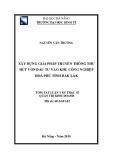


![PET/CT trong ung thư phổi: Báo cáo [Năm]](https://cdn.tailieu.vn/images/document/thumbnail/2024/20240705/sanhobien01/135x160/8121720150427.jpg)
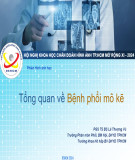
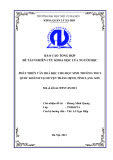

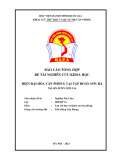
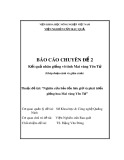






![Báo cáo seminar chuyên ngành Công nghệ hóa học và thực phẩm [Mới nhất]](https://cdn.tailieu.vn/images/document/thumbnail/2025/20250711/hienkelvinzoi@gmail.com/135x160/47051752458701.jpg)









